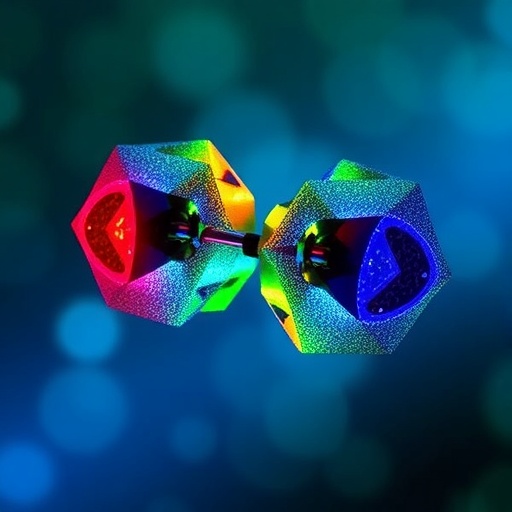In the relentless pursuit of next-generation photovoltaic technologies, all-perovskite tandem solar cells have emerged as frontrunners, promising unprecedented power-conversion efficiencies (PCE) by combining wide-bandgap and narrow-bandgap perovskites. However, the full potential of these tandem architectures has been constrained by fundamental material and interface challenges, especially at the buried interface between the hole transport layer (HTL) and the narrow-bandgap (NBG) perovskite subcell. This interface stands as a critical bottleneck, prominently limiting device performance due to non-radiative recombination losses.
In an important breakthrough, researchers have unveiled a novel dipolar passivation strategy that not only mitigates interfacial trap states but also precisely tailors the energy level alignment at the HTL/perovskite junction. This dual-function approach radically transforms the interface by simultaneously enhancing charge extraction and reducing unwanted recombination. By doing so, it opens new avenues for improving the efficiency and stability of lead-tin (Pb-Sn) based narrow-bandgap perovskite solar cells, which are integral for high-efficiency all-perovskite tandem devices.
The challenge of minimizing non-radiative recombination losses at the HTL/perovskite interface has long been magnified in lead-tin mixed perovskites. Conventional passivation approaches predominantly rely on long-chain amine molecules that introduce insulating layers, impeding charge transport. While these methods reduce trap states, they unintentionally compromise both the fill factor (FF) and the short-circuit current density (J_sc), fundamentally limiting the output power and efficiency of the cell. The delicate balance between effective passivation and efficient charge extraction has remained elusive—until now.
The new dipolar passivation method leverages molecular dipoles to engineer the electrostatic landscape at the interface. By depositing a thin, dipolar layer, the researchers induced a favorable energy level alignment that facilitates ohmic contact between the perovskite and the HTL. This configuration markedly improves hole injection efficiency while simultaneously repelling electrons, thereby suppressing recombination at the interface. Such precise control over interfacial energy levels exemplifies a sophisticated yet pragmatic strategy to overcome long-standing material limitations.
One of the remarkable consequences of this passivation strategy is the dramatic extension of the carrier diffusion length within the Pb-Sn perovskite layer, reaching an impressive 6.2 micrometers. This enhancement is critical because longer diffusion lengths enable photo-generated carriers to traverse the perovskite absorber without recombining prematurely, thereby maximizing current extraction and device efficiency. By ensuring that more charge carriers contribute to the electrical output, the strategy effectively elevates device performance metrics on multiple fronts.
Performance-wise, the impact of the dipolar passivation approach has been significant. Pb-Sn perovskite single-junction devices treated with this strategy achieved a power-conversion efficiency of 24.9%, with an open-circuit voltage (V_oc) of 0.911 V—a noteworthy improvement considering the traditionally challenging nature of Pb-Sn perovskites. Additionally, these devices exhibited a high short-circuit current density (33.1 mA/cm^2) and an excellent fill factor of 82.6%, parameters that underscore the superior charge collection dynamics enabled by the passivated interface.
Beyond single-junction devices, the dipolar passivation technique holds profound implications for all-perovskite tandem solar cells. The researchers demonstrated that passivation effectively mitigates contact losses frequently induced by the interconnecting layers that bridge the wide-bandgap and narrow-bandgap subcells. These interfacial modifications translate into tandem devices that exhibit remarkable power-conversion efficiencies, reaching 30.6% under standard test conditions, with stabilized efficiencies certified at 30.1%.
This efficiency milestone positions all-perovskite tandem solar cells as highly competitive candidates for next-generation photovoltaics, surpassing many incumbent technologies in both performance and material sustainability. The findings not only offer a solution to interfacial recombination but also showcase how molecular engineering at buried interfaces can unlock substantial gains in device performance without compromising stability or manufacturability.
The interdisciplinary nature of this research—merging molecular chemistry, materials science, and device engineering—highlights the importance of interface science in renewable energy innovation. It opens a new chapter in perovskite solar cell research, where precise interfacial control is as critical as the bulk optoelectronic properties of the absorber materials themselves. These advances may accelerate the commercialization timeline of all-perovskite tandem photovoltaics, potentially reducing costs and boosting adoption worldwide.
Furthermore, considering the scalability of the dipolar passivation process, its integration into existing perovskite device fabrication protocols appears feasible. This adaptability is crucial for transitioning laboratory-scale breakthroughs into industrial-scale manufacturing, thereby facilitating the deployment of high-efficiency tandem modules in real-world solar installations.
The reported outcomes stem from meticulous experimentation combined with sophisticated characterization techniques to unravel and optimize the molecular dipole effects at the buried interface. These efforts underscore the importance of fundamental understanding in interface phenomena, emphasizing that future enhancements will likely continue to arise from smart chemical and physical passivation schemes.
As the photovoltaic community pushes towards the elusive 35% efficiency target for tandem solar cells, the insights from this dipolar passivation research provide a clear pathway. By addressing one of the most stubborn losses in narrow-bandgap subcells, this approach paves the way for perovskite tandems to achieve efficiencies previously thought to be out of reach, heralding a new era of solar energy harvesting that is both efficient and scalable.
In conclusion, the innovative dipolar passivation method introduced offers a transformative strategy for tackling interface-related recombination losses in Pb-Sn perovskite solar cells. Its profound impact on charge carrier dynamics, energy level alignment, and overall device performance represents a significant leap forward in the perovskite photovoltaic field. This breakthrough not only advances the fundamental understanding of buried interface physics but also brings the vision of high-efficiency, all-perovskite tandem solar technology closer to reality.
Subject of Research: Development of dipolar passivation strategies to reduce non-radiative recombination and improve efficiency in lead-tin narrow-bandgap perovskite solar cells and all-perovskite tandem solar cells.
Article Title: All-perovskite tandem solar cells with dipolar passivation.
Article References:
Lin, R., Gao, H., Lou, J. et al. All-perovskite tandem solar cells with dipolar passivation. Nature (2025). https://doi.org/10.1038/s41586-025-09773-7
Image Credits: AI Generated
Tags: all-perovskite tandem solar cellscharge extraction enhancementdipolar passivation strategyenergy level alignment perovskitehigh-efficiency photovoltaic technologieshole transport layer interfaceinterface trap states mitigationlead-tin perovskite solar cellsnarrow-bandgap perovskite challengesnon-radiative recombination lossespower-conversion efficienciesstability of tandem devices





